We love artists' books: the finished boxes!
You may recall that back in July I blogged about these two beauties that came to the Lab for custom enclosures. They both returned to PLCH at the beginning of September in their custom enclosures, so I thought I’d share what type of enclosures we came up with to address all the fragile elements of these particular artists’ books.
Spirit Book #11: Terrestrial Talisman –
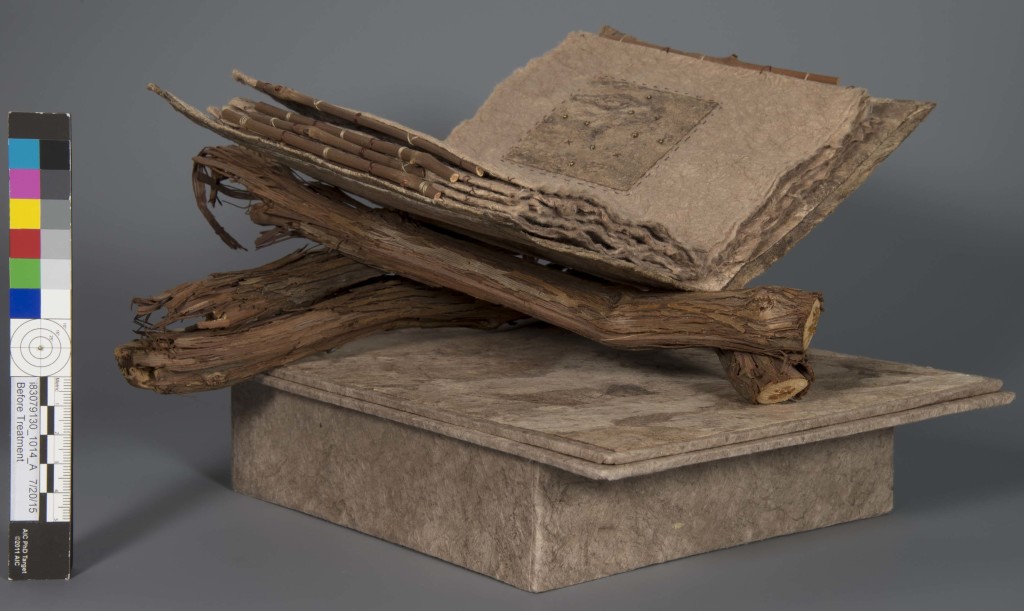 This artist book consists of a base, a grape-vine cradle and a handmade book and was assigned to conservation tech, Chris Voynovich, to create the enclosure.
This artist book consists of a base, a grape-vine cradle and a handmade book and was assigned to conservation tech, Chris Voynovich, to create the enclosure.
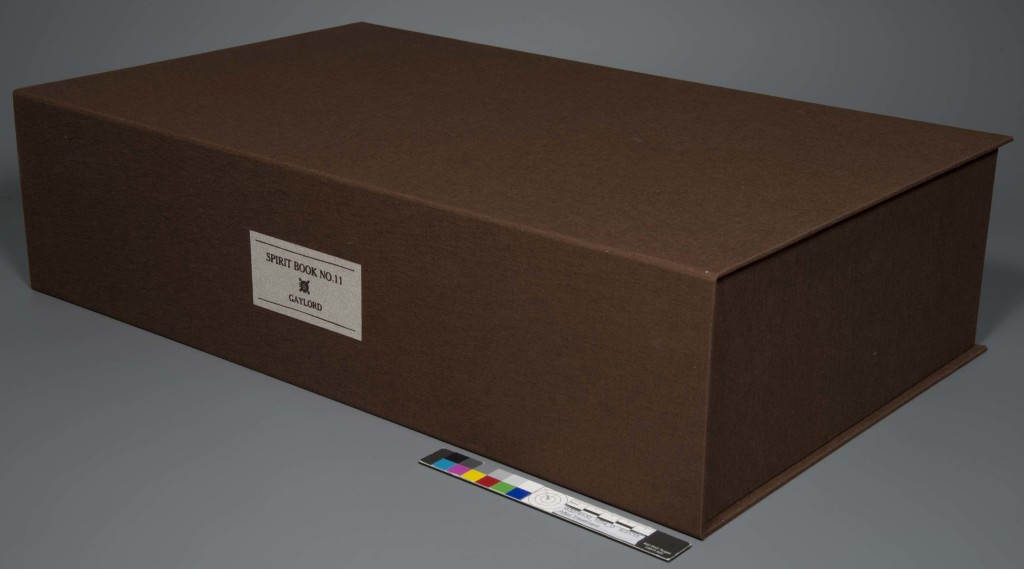
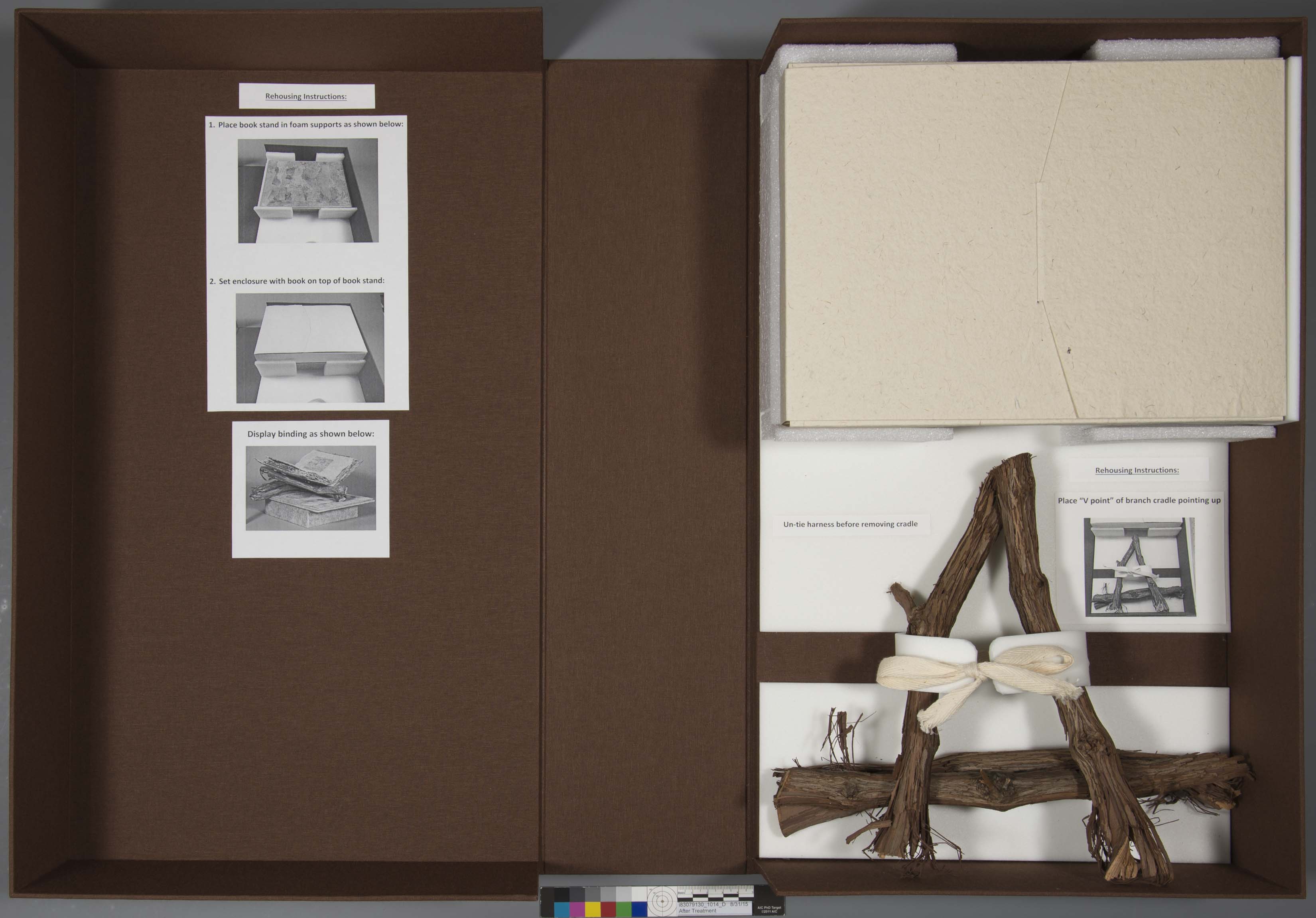 Chris, known for his masterful box-making skills and ingenuity around the Lab, created a beautiful cloth-covered clamshell box, in what seemed like a flash! He placed the book in a polyester film tuxedo box to protect it during handling by patrons yet keep it visible, then he placed that in a larger tuxedo box constructed out of handmade paper (to mimic the artist books’ amate paper) with foam filler. This tuxedo box was the same height and width as the artist book base, so that it could easily be stored on top of the base in the clamshell box. Next up, the grape-vine cradle! Chris wanted something gentle yet to secure to keep the fragile cradle in place. He opted to create a harness out of Volara foam and linen tape.
Chris, known for his masterful box-making skills and ingenuity around the Lab, created a beautiful cloth-covered clamshell box, in what seemed like a flash! He placed the book in a polyester film tuxedo box to protect it during handling by patrons yet keep it visible, then he placed that in a larger tuxedo box constructed out of handmade paper (to mimic the artist books’ amate paper) with foam filler. This tuxedo box was the same height and width as the artist book base, so that it could easily be stored on top of the base in the clamshell box. Next up, the grape-vine cradle! Chris wanted something gentle yet to secure to keep the fragile cradle in place. He opted to create a harness out of Volara foam and linen tape.
Any Number of Things: Being the Story of Events Leading –
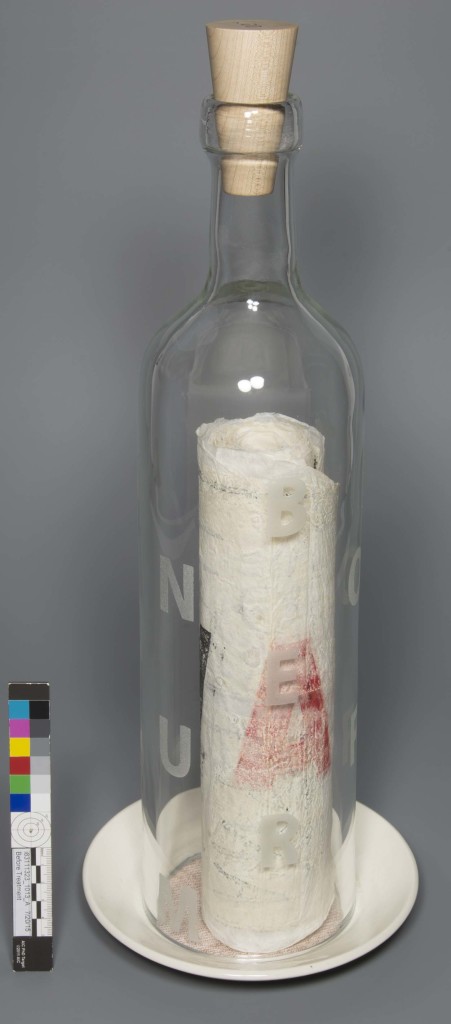 I was assigned Any Number of Things, which consists of a 9+ foot long scroll, a hand-blown, bottomless glass bottle, a ceramic plate/base, and a wooden stopper. I desperately wanted to create the enclosure for this artist book because I had never created a complex cloth clamshell before, only ones with modest filler for miniature books. Little did I know that in the end I wouldn’t be making a “clamshell box” or how complex and Frankenstein-like this enclosure would become…
I was assigned Any Number of Things, which consists of a 9+ foot long scroll, a hand-blown, bottomless glass bottle, a ceramic plate/base, and a wooden stopper. I desperately wanted to create the enclosure for this artist book because I had never created a complex cloth clamshell before, only ones with modest filler for miniature books. Little did I know that in the end I wouldn’t be making a “clamshell box” or how complex and Frankenstein-like this enclosure would become…
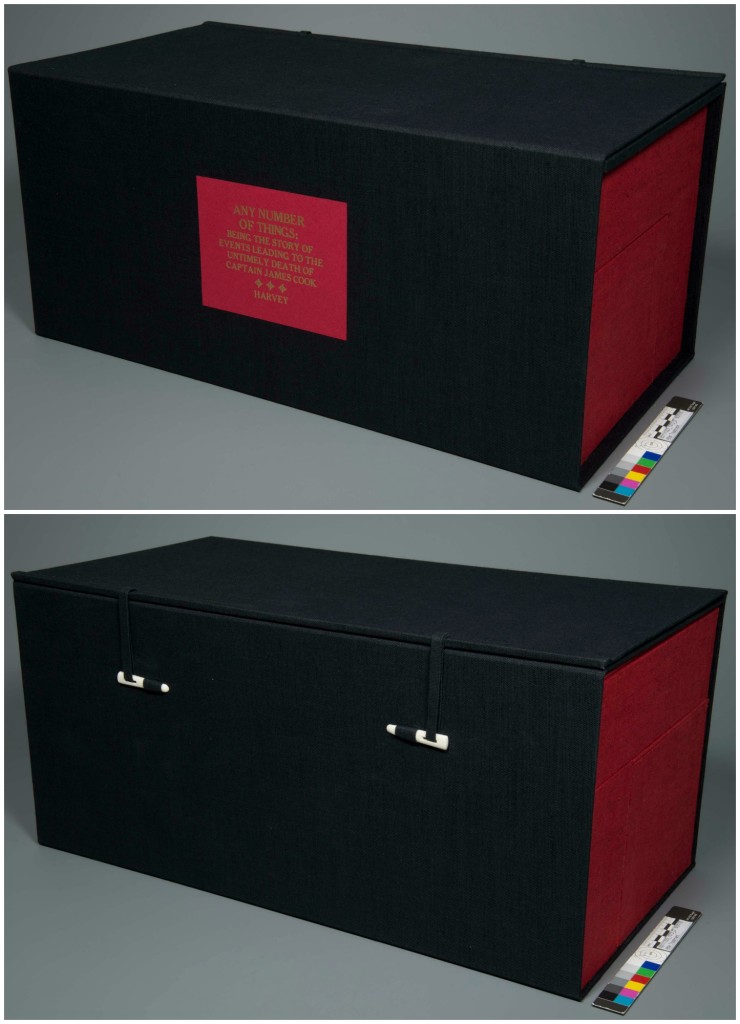 The finished product was a hodge-podge of different enclosure styles/techniques, which didn’t create the most straightforward of enclosures…BUT really tested my ability to adapt, learn, and problem-solve as I worked. With this enclosure I carried out a lot of techniques and methods that I had never tried before, so it was a wonderfully valuable learning experience for me personally. The end result: two enclosures secured within a Japanese style wrap-around case, complete with bone clasps. The two interior enclosures each housed two parts of the four piece artist book.
The finished product was a hodge-podge of different enclosure styles/techniques, which didn’t create the most straightforward of enclosures…BUT really tested my ability to adapt, learn, and problem-solve as I worked. With this enclosure I carried out a lot of techniques and methods that I had never tried before, so it was a wonderfully valuable learning experience for me personally. The end result: two enclosures secured within a Japanese style wrap-around case, complete with bone clasps. The two interior enclosures each housed two parts of the four piece artist book.
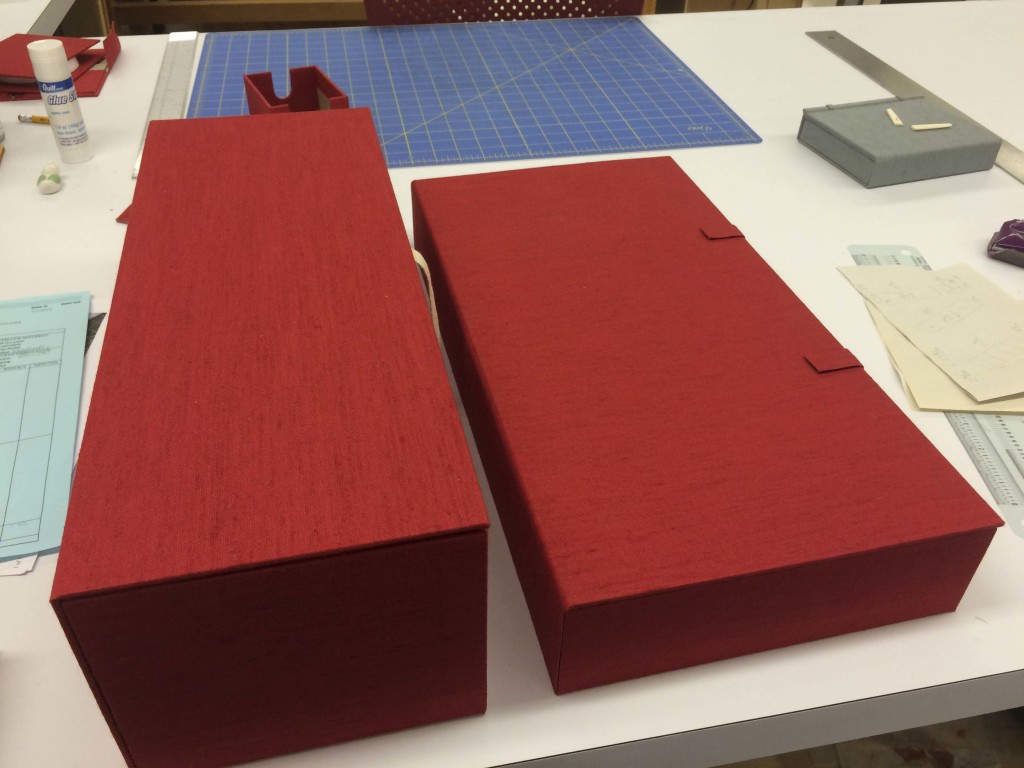 Originally I had planned to house all the components in one tray, like Chris had done with Spirit Book #11. But I feared the heaviness of the glass bottle would have made for a very unbalanced tray. I also worried how much space a single-layered tray like that would take up on the shelf. So, after I had already begun working I changed and adapted my plans to create a box for the glass bottle, with the rolled scroll housed inside the bottle, and another box to house the ceramic plate and wooden stopper.
Originally I had planned to house all the components in one tray, like Chris had done with Spirit Book #11. But I feared the heaviness of the glass bottle would have made for a very unbalanced tray. I also worried how much space a single-layered tray like that would take up on the shelf. So, after I had already begun working I changed and adapted my plans to create a box for the glass bottle, with the rolled scroll housed inside the bottle, and another box to house the ceramic plate and wooden stopper.
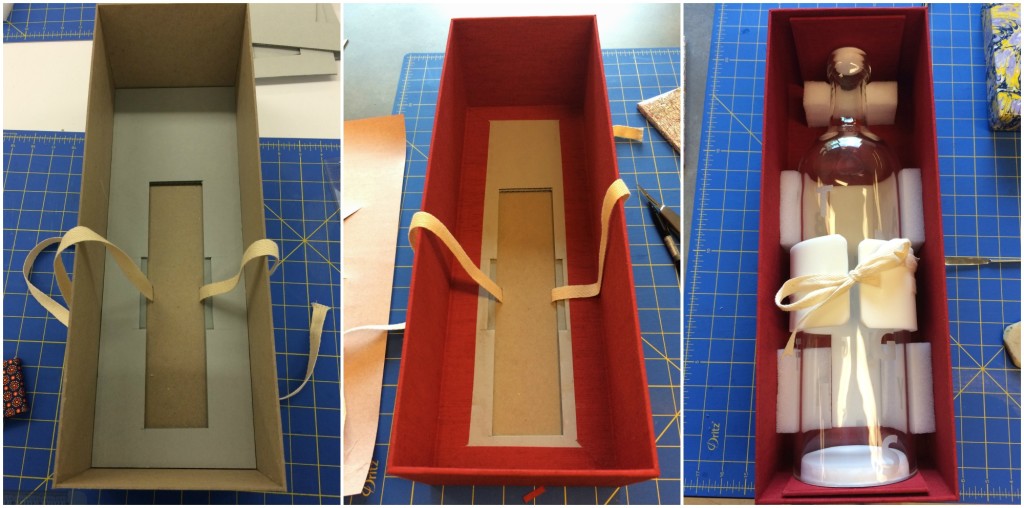 Glass bottle/scroll box: I created a Volara foam harness with a linen tie laced through the bottom of the box and the foam to secure the bottle within the box. I supported the bottle with Ethafoam at the neck and on either side.
Glass bottle/scroll box: I created a Volara foam harness with a linen tie laced through the bottom of the box and the foam to secure the bottle within the box. I supported the bottle with Ethafoam at the neck and on either side.
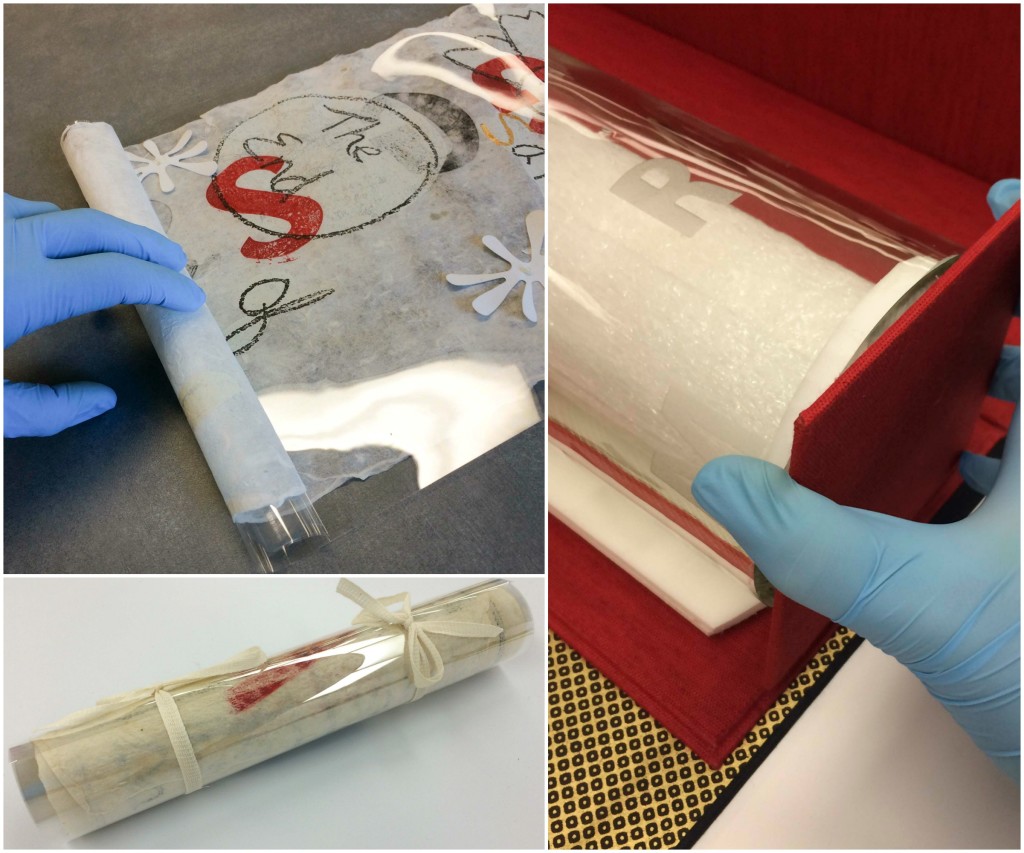 The entire length of the scroll was rolled onto a long sheet of .3 mil polyester film and then secured with linen tying tapes. Then the parcel was wrapped in Ethafoam sheeting to prevent any shifting while it was housed in the glass bottle. I created a foam stopper for the base of the glass bottle to keep the scroll parcel secured while the bottle was being removed/placed in the box.
The entire length of the scroll was rolled onto a long sheet of .3 mil polyester film and then secured with linen tying tapes. Then the parcel was wrapped in Ethafoam sheeting to prevent any shifting while it was housed in the glass bottle. I created a foam stopper for the base of the glass bottle to keep the scroll parcel secured while the bottle was being removed/placed in the box.
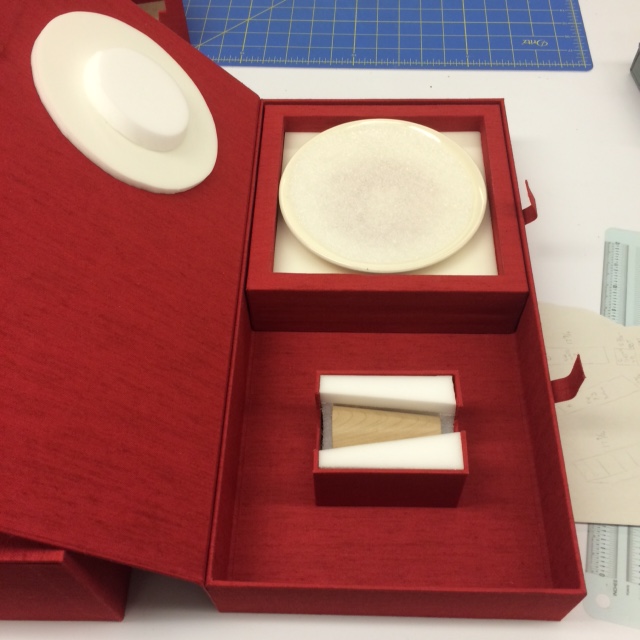 Ceramic plate/stopper box: For this box I created a tray lined with layers of Volara foam on the bottom to house the ceramic plate. I further secured the plate with foam supports on the lid of the box. I made a mini tray with Ethafoam and plastazote foam supports for the wooden stopper. For this box, I used rare earth magnet closures…which was new and exciting for me, since I’ve never used them in an enclosure before.
Ceramic plate/stopper box: For this box I created a tray lined with layers of Volara foam on the bottom to house the ceramic plate. I further secured the plate with foam supports on the lid of the box. I made a mini tray with Ethafoam and plastazote foam supports for the wooden stopper. For this box, I used rare earth magnet closures…which was new and exciting for me, since I’ve never used them in an enclosure before.
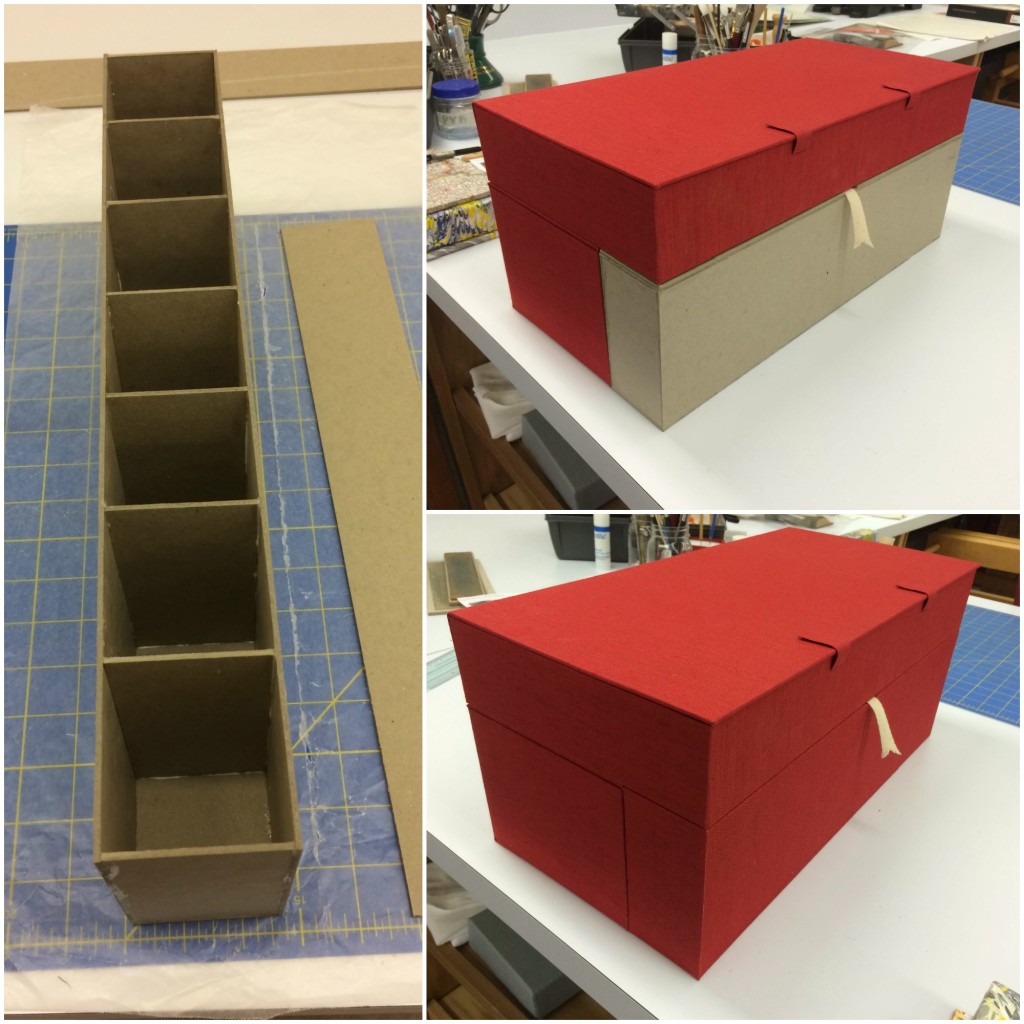 Before I could create the Japanese style wraparound case I had to create a filler/support piece that would sit next to the bottle/scroll box so that both levels of the enclosure would be the same width. I used supports throughout this rectangular piece so that it would support the weight of the top enclosure.
Before I could create the Japanese style wraparound case I had to create a filler/support piece that would sit next to the bottle/scroll box so that both levels of the enclosure would be the same width. I used supports throughout this rectangular piece so that it would support the weight of the top enclosure.
In the end, this enclosure took a ton of time and turned out a little strange and Frankenstein-esque, but it was an outstanding learning experience for me! If I could do it all over again, I probably would have created a very different enclosure…something perhaps a little more simplistic! And I wouldn’t have stabbed myself with my scalpel halfway through (no worries, all fingers are intact!). But what I learned during making this enclosure was invaluable and will definitely help me make better enclosures in the future. So bring on more strange/complex artist books, please!
Check out these videos: plate and stopper box video and glass bottle box video
Jessica Ebert (UCL) — Conservation Technician
